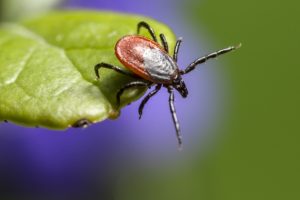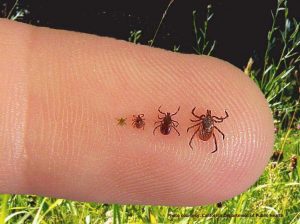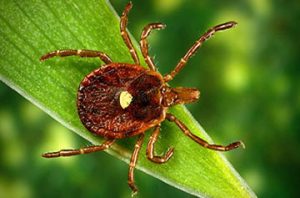Ticked off about ticks? You are not alone. And knowing the what, where, why, etc. is critical to knowing how to deal with them. So here it is, the first in a series: the low-down on that pest we love to hate.
May you, dear reader, stay tick-free and healthy.
1. What, exactly, is a tick?
Ticks are related to mites and spiders—but not to insects. (Now don’t go worrying about spiders—in the Northeast, virtually all are common victims of common misunderstandings.) Ticks have four life stages: egg, larvae, nymph and adult. All stages (well, not the eggs) feed on blood for energy to grow and later to reproduce. Larval ticks have six legs; nymphs and adults have eight.

Right now, three species are a health concern here in New York: the blacklegged tick, the lone star tick, and the American dog tick.
2. What do ticks look like?
Regardless the species, unfed ticks look like flattened teardrops with eight legs. And depending on their species, life stage and sex (male versus female), they have different color patterns on their bodies. But after they’ve eaten, their abdomens (the females’ especially) can expand so much that it’s really hard to know which is which. You can get positive IDs here.
- Cornell University Cooperative Extension office in your county
- Cornell University Insect Diagnostic Laboratory
- IdentifyUS
- TickEncounter Resource Center
Just keep in mind that learning a tick’s identity doesn’t mean you know if it’s carrying a disease.

As for size? Again, that depends on the species, its life stage, and whether it has fed (and for how long). For blacklegged and lone star ticks, larvae are the size of the period at the end of this sentence. Nymphs? Think poppy seeds. Adults? Sesame seeds. When fully fed, adult females can be as large as a raisin.
American dog ticks, though, are a tad larger than the other two.
3. Are ticks a new problem? Why have we been hearing so much more about them lately?
Turns out ticks are nothing new. In fact, evidence suggests that ticks were carrying Lyme disease pathogens 15 to 20 million years ago (Lyme Disease’s Possible Bacterial Predecessor Found in Ancient Tick). What is new? We’re seeing far more ticks throughout the Northeast and much of North America than during any time in recorded history. And of course the more ticks in the neighborhood, the greater our risk of disease.
Why are ticks on the move? For one, (sub)urban sprawl leaves small patches of wooded areas—great habitat for mice and deer but far less welcoming to their traditional enemies—hawks or foxes, cougars or wolves. (More later on the role of mice and deer in tick-borne diseases.) In addition, a warming climate makes northern areas more hospitable for ticks.

4. Where do ticks live? How do they find me? And where did the deer ticks go?
Blacklegged ticks are usually found in woodlots, forest edges, and groundcovers such as pachysandra or periwinkle—places where leaf litter, shrubs, and tree cover provide the moist environment they need. And how do they find us? Just as we sometimes go on quests, so too do they. Only they’re not seeking adventure or the Holy Grail, but simply a host. A host that provides the food (think blood) they need to thrive, or at least survive.
About deer ticks? Years ago, researchers thought they’d found a new species and gave it the common name “deer tick.” Turned out it was the same old blacklegged tick that’s been here since time immemorial.
No matter that these ticks lack eyes—questing ticks stand on the edge of a twig or leaf, their first pair of legs extended. Evolution endowed them with cleverly designed legs: they’ve got sensors to detect temperature, the carbon dioxide those hosts exhale, and odors or sounds specific to those hosts. When a host brushes past, they grab on tight.
The nymphs typically quest below a person’s knee-height. Because adult ticks feed on larger animals, they might quest higher up to find a host—as high as your waist-height or mine.

The lone star tick thrives in a wide range of habitats, from shady forests to sunny lawns or roadsides. Unlike the blacklegged tick, the lone star tick hustles toward its prey, even across pavement or dry sand. Other distinguishing features? Well … it’s lots more aggressive. Imagine a tick that travels three times as fast as the blacklegged tick, has excellent vision, and hatches in stinging swarms that can put fire ants to shame.
Last but not least—the American dog tick. Forget the woods: this tick thrives in warm, dry places—roadsides, grassy fields, scrubland and lawns. Larvae and nymphs mostly feed on small mammals, while adults climb grass, brush, or twigs to find medium-sized animals—people included. And sometimes American dog ticks could be even more aggressive. TickEncounter has reported seeing American dog ticks follow a regular source of carbon dioxide that attracted them for upward a few hundred yards to the house. And in one memorable case ticks were crawling up the outside walls toward window screens and doors. Now if that doesn’t give you the willies….
No matter which tick you might collide with—this is one party you don’t want to host.
Stay tuned for another informative post on the biology behind that pest we love to hate.
(Adapted from nysipm.cornell.edu/whats-bugging-you/ticks/tick-faqs#answers)